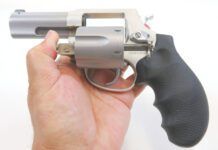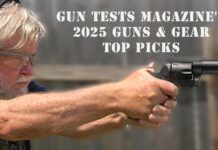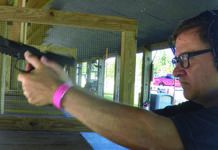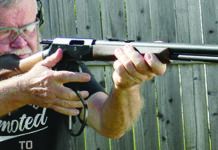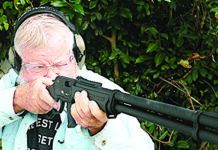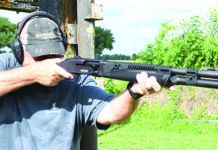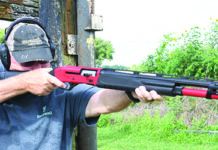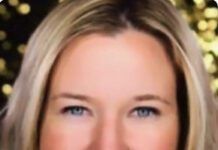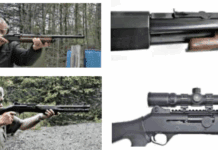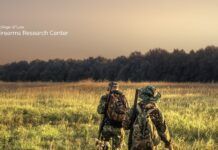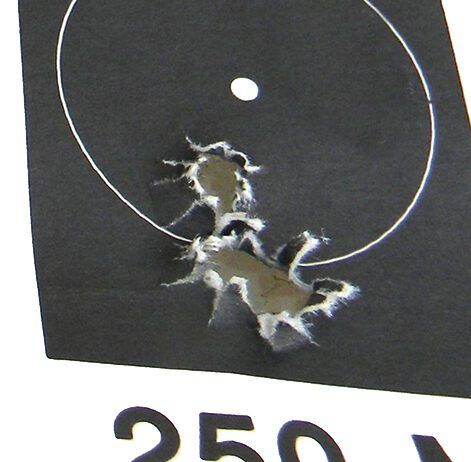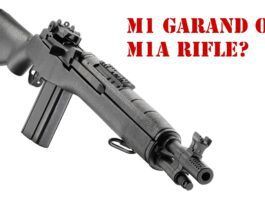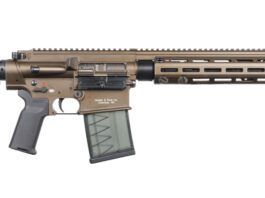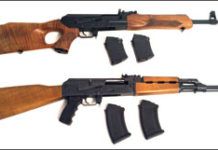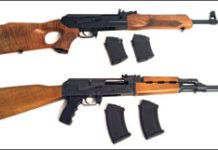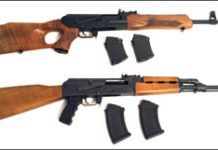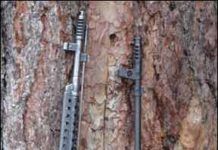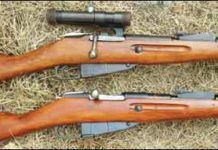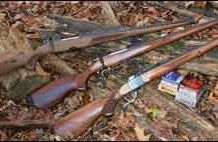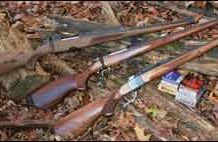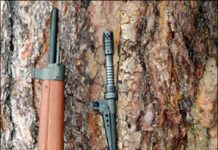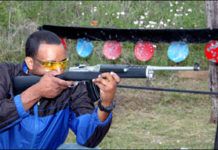All-Round 308 Winchester Rifle Shoot-Out: Not Our Faves
Looking for a go-anywhere do-anything 308 Winchester-chambered rifle? If so, in this article we test Remington SPS bolt guns in two variants, a Tactical version with a carbine-length barrel at 16.5 inches and the 26-inch barrel SPS Varmint, to get a good look at opposite ends of the length spectrum. Then we added two rifles with more traditional barrel lengths, the 22-inch-barrel Savage Axis and a semi-auto, the Browning Automatic Rifle Stalker, also with a 22-inch tube.
The truth is, these rifles will fire most of their cartridges on a range. This means we'd like them to be comfortable to shoot and deliver satisfying accuracy. Hunting is a consideration, of course, so the rifle should be useful for thin-skinned game to 200 yards or more. The adage of "200-pound game at 200 yards" will apply here. In a dangerous world in which it may be the only self-defense option for some homes, the rifle should also have some utility as an emergency rifle or for area defense. It should handle quickly enough for boar hunting, or varmints and pests, such as coyotes if need be. Area defense simply means that those of us with a larger homestead or a potential campsite do not wish to be helpless if we encounter adversaries. And we'd prefer our choice not cost as much as a Scout.
Obviously, then, we want a dependable, easy-to-shoot, easy-to-carry rifle that's well made. Doesn't sound that hard because we are not expecting to be able to light a match with each round, but we do want to hit the K zone at 200 yards. Some shooters have claimed that shorter, stiffer barrels like that on the Tactical shoot as well as a longer barrel, like that on the Varmint. We are going to see how velocity varies as well, and to compare the chronograph stats bolt guns develop in terms of velocity to that of a semi-auto. We do not want a 4-foot-long 12-pound rifle, but we wondered if we would have to compromise on weight (that is, go heavier) if we do not get the accuracy we want. We are not holding out for accuracy for 50 continuous shots and do not need a heavy target barrel, but, instead, we're looking for a rifle capable of delivering good accuracy for a dozen shots or so. Durability and quality are important. The rifle should last for the shooter's entire life. Also, to save money, we looked for used rifles in Like New or better shape, a standard which all four members of the quartet met.
We elected to fire the rifles in four drills. We would fire quickly at human-silhouette targets at 25 yards, for the SHTF situation. It is also a drill that has some merit in learning to snap-shoot predators and coyote. At 50 yards, we used the Innovative Targets (Innovative Targets.net) steel gong. While we fired for precision, we also wished to test speed to an extent in this drill and fired a combination of standing and kneeling. We would expend 20 rounds in each pursuit, at 25 and 50 yards, for 40 rounds. We also fired 10 rounds at 100 yards offhand. Finally, we fired three three-shot groups for accuracy at 100 yards with three different loads, alternating between rifles to let the barrels cool, firing from a solid rest and attempting to obtain the best accuracy possible. During the offhand firing stages, we used Fiocchi 150-grain FMJs for the 25- and 50-yard work. For firing offhand at 100 yards, we used a handload consisting of the Hornady 155-grain SST and Varget powder for 2750 fps. For benchrest accuracy testing, we used three loads. The Hornady 168-grain ELD Match, Federal 165-grain Trophy Bonded, and Gorilla Ammunition's 175-grain Sierra MatchKing load. Here's how they performed.
All the cartridges tested gave good-enough results as far as baseline expectations, we thought. That is, we had no failures to feed, fire, or eject in the test. And all three produced a level of accuracy we want to see—1 minute of angle, or 1-inch groups at 100 yards—in at least one rifle. For example, the Gorilla Ammunition 175-grain rounds gave the best results in the Remington SPS Varmint at an eye-popping 0.9-inch average group size, then the SPS Tactical at 1.2 inches, the BAR Stalker semi-auto at 1.6 inches, and the Savage at 1.9 inches on average, far behind the leader. We saw the same pattern with the Hornady ELD Match 168-grain Polymer Tip load, with the Varmint again shooting under MOA with a 0.9-inch average group, the Tactical at 1.4 inches, the MK3 BAR at 1.5 inches, and the Axis coming in at 2.3 inches. Likewise, the SPS Varmint lead the parade with the Federal Trophy Bonded 165-grain Polymer Tip load, shooting 1.0-inch average groups. The BAR jumped into second place with this load, shooting slightly better at 1.7 inches than the Tactical's 1.9-inch average. The Axis was fourth again with an average group size of 2.2 inches.
Beretta Unveils APX Striker Gun
Beretta's APX, a new striker-fired full-size pistol in 9x19mm, 9x21mm IMI and 40 Smith & Wesson cartridges, debuted at the 2015 International Defence Exhibition & Conference IDEX expo in Abu Dhabi Feb. 22.
"IDEX is one of the first venues where defense contractors present their wares to worldwide military customers and Beretta felt this was the ideal environment to present the international offering of its APX pistol," said Carlo Ferlito, general manager of Beretta and Beretta Defense Technologies (BDT) vice president.
Beretta intends to market a variant for the commercial market later this year. The new Beretta APX has an ergonomically-molded reinforced polymer frame fitted with a built-in MIL-STD-1913 Picatinny rail, interchangable backstraps and grip panels, and a modified Browning locking system. The APX is 7.56 inches long with a 4.25-inch barrel.
The trigger can be considered a light double action, with a 6-pound break, 0.2 inch of travel, and a 0.12-inch reset. The rear portion of the striker slightly protrudes from a round slot on the back of the slide as a loaded-chamber indicator.
The slide is machined from stainless steel and has a nitride coating that reduces glare, scratches, and corrosion. Other features include wide front and rear slide serrations, three-dot sights dovetailed into the slide, and no manual safety save for a Glock-style trigger safety.
Ferlito said, "Beretta waited to enter the striker-fired market until we had a pistol we knew would meet the needs of the operator. The APX has been more than three years in development. We tested it extensively with professional end users and incorporated that feedback at every opportunity. The result is a pistol platform that delivers superior performance in durability, reliability, accuracy and ergonomics."
A slot on the frame allows the use of a tool to decock it before it can be field-stripped by operating a lever found on the left side of the frame.
An optional manual safety system will be available upon request, consisting of a frame-mounted two-position switch. A reversible magazine-release catch and a factory ambidextrous slide stop/hold open release lever help make the pistol suitable for left- or right-handed shooters.
Supplied black double-stack metal magazines have polymer bottom pads and offer 17-round capacities in 9x19mm NATO and 15-round capacities in 9x21mm IMI (9 Italian) and 40 Smith & Wesson.
Lo-Cap AK-47s: We Compare K-VAR VEPR, CIA N-PAP Rifles
Lo-Cap AK-47s: We Compare K-VAR VEPR, CIA N-PAP Rifles
Lo-Cap AK-47s: We Compare K-VAR VEPR, CIA N-PAP Rifles
Two 7.62x54R Semiauto Rifles: Surplus Tokarev Beats PSL-54C
Classic Military Bolt-Action Rifle Shootout: Lee Enfield Wins
During World War I and World War II, and in some cases beyond, there came four great bolt-action rifles in martial actions: the Lee Enfield, the Mauser, the Mosin Nagant and the Springfield. While there were many variations among the rifles, we all know what a Lee Enfield and a Mauser look like. The Nagant was produced in the many millions, and the Springfield is sometimes regarded as a rifle with almost magical accuracy. These rifles wrought many a bloody victory for one side or the other in warfare from about 1903 onward. The Lee Enfield and Mauser rifles are still seen in action in Afghanistan today. Recent events in India showed Indian security forces armed with the Lee Enfield, probably a homegrown version. These rifles simply refuse to die. While these four are the great battle rifles of the 20th century, there were other contenders for the test program that were considered and discarded. The excellent Schmidt Rubin straight-pull rifle was considered, but since it didn't figure into warfare it was not included. The French rifles are a bit quirky for our tastes, and ammunition is difficult to obtain. Likewise, the Italian Carcano is not really in the league with the others. We admit the Japanese Arisaka is an omission, but we were unable to find a suitable firing version within our time frame. We used four rifles primarily during the test program and added two special interest rifles for a side comparison as well. In the end we think we have a good idea of the handling properties of the rifles used in the Great Wars.
Mosin Nagants: We Pit Two Versions of the Hoary 1891/30
The ancient Mosin Nagant rifle has a storied history. It was the first magazine rifle adopted by Russia, back in 1891. The early versions harked back to Civil War rifles as to overall length. The first version of the rifle was over 50 inches long, and by 1930, as with our test rifles, the length is still over 4 feet. Add a bayonet and the gun resembles a spear more than a modern rifle. However, the basic design is still being used by many troops who need a stout bolt-action rifle, well over a century after its introduction. The Mosin Nagant will never win any beauty contest, mostly because of its drop-down magazine, and we don't know of any custom sporters built on them, though they surely exist. However ugly the rifle may be, it has served long and well as a prime military weapon.
In this report we tried to find out how good a military rifle the 1930 variant was, and if it was any better with a scope. To that end, we acquired two of the long Model 1891/30 rifles, which designation indicates the original design was seriously modified in 1930. One of our test rifles was a common variety and the other, the "sniper" version with a reproduction period scope. The two rifles came with a package of bayonet, sling, and cleaning materials. We tested them with three bullet types and weights, 150-grain soft-point boattail, 182-grain FMJ BT, and 203-grain soft point. The first two types of our test ammo were made by the Serbian Prvi Partizan company, and the third by Brown Bear, out of Russia. Here's what we found.
Mannlicher-Style Hunting Rifles: CZ Outduels Ruger and Steyr
Mannlicher-Style Hunting Rifles: CZ Outduels Ruger and Steyr
French MAS Semiautos: History-Making Rifles Compete
Long before WWI the French were hard at work on semiauto rifle designs. Unfortunately they didn't have much in production at the start of the Great War, so they fought that war largely like the rest of the world did, with bolt-action rifles. It was not until 1949 that France had its own successful semiauto rifle in the MAS, chambered for the 7.5x54mm cartridge, which is similar to the 7.62 NATO round. That rifle was designated the Model 1949, and it incorporated some features of the bolt-action Model 1936, including its cartridge, rear-sight arrangement and two-piece stock. Later modifications developed the M1949 into the Model 1949-56. For this report we acquired one of each type from Collectors Firearms (www.collectorsfirearms.com), the M1949 chambered for the original cartridge and the ‘49-56 rechambered by some arsenal to 7.62 NATO. The French cartridge is a bit longer and very slightly fatter than the NATO cartridge, so we presume the barrel had to be set rearwards to effect the conversion.
MAS stands for Manufacture Nationale d'Armes de St-Etienne. This is a gas-driven design that would be familiar to the fans of the various AR-15/M-16 rifles. The gas tube impinges directly on the bolt carrier, blowing it rearward with each shot. There are no moving parts, like pistons or pushrods, in the gas system.
Although the rifles had essentially the same actions, the M1949 had only a stacking lug at the front and no muzzle brake, presenting what amounted to a naked barrel muzzle. The ‘49-56 had a grenade launcher, muzzle brake/flash hider, and folding grenade sights. The rear sight on each rifle was an aperture, adjustable upward from 200 to 1200 yards. The front blade on the M49 was a fixed post, but the later rifle had an elevation-adjustable front post.
The detachable magazines had their clasp as part of the magazine, a simple and rugged system that locked into a notch cut in the right side of the action. The 10-round magazines were interchangeable between our two test rifles. Apparently higher-capacity magazines have been available for the MAS rifles. The original parts kits issued with the rifles apparently were well thought out and included critical spare parts, magazines, bayonet, cleaning stuff, and for some, a compact 3.9X scope. All the MAS rifles have a rail on the left side of the action permitting easy scope mounting.
The later rifle had a larger trigger guard, permitting firing with gloves. Both rifles had a simple leather sling attached to the left side of the rifle. The 49-56 had a black slip-on recoil pad, apparently original issue.
Each rifle had a two-piece hardwood stock with a wood hand guard covering the forward part of the barrel and the gas tube. The woods were plain walnut and birch. The safety consisted of a lever located to the right front of the trigger guard. In the safe position it partially obscured the trigger opening, which was more obvious for right handers. Both bolts had a serrated white plastic covering on the bolt knob. The actions were solid, well-made, nicely machined items that looked to be extremely strong. There were no plastic nor flimsy metal parts anywhere on either rifle. These were serious war-time rifles made to work and to last.
Takedown for these rifles was remarkably simple. After clearing the rifle, remove the magazine and let the slide go forward. Then slide the large button at the rear of the receiver downward, toward the wrist of the rifle. Press forward on the top-rear portion of the action, which is the cover, and when it moves just over half an inch toward the front of the rifle it can be lifted off toward the rear, releasing tension on the recoil spring. Then slide the bolt carrier rearward until the bolt and carrier are all the way back, and they can then be lifted out. That's it. With a normal cleaning rod the barrel must be cleaned from the front. For reassembly reverse the process. You have to fight the spring a bit, but it's an easy job. If you have to remove the trigger assembly, you'll need a screwdriver to remove a slotted screw at the rear of the trigger guard.
Largely because of extremely poor winter weather, we tested the two rifles with one type of ammo each. For the Model 1949 we used Serbian Prvi Partizan 139-grain FMJ, and for the 1949-56 we used Magtech 150-grain FMC. Here's what we found.


